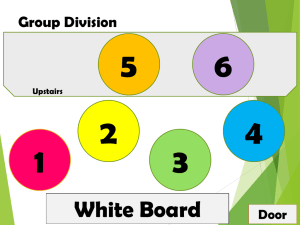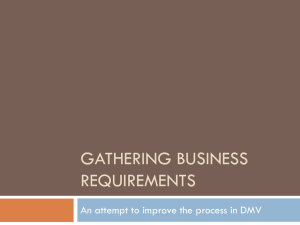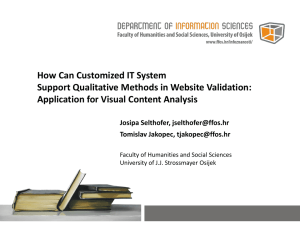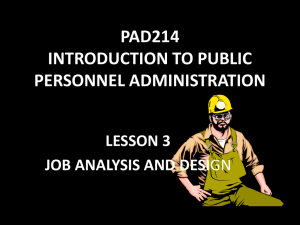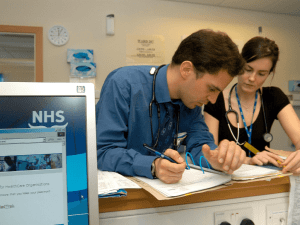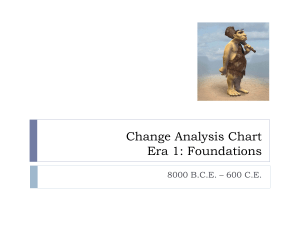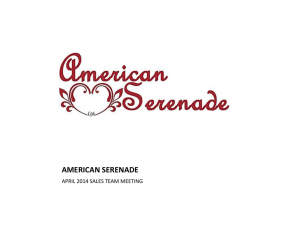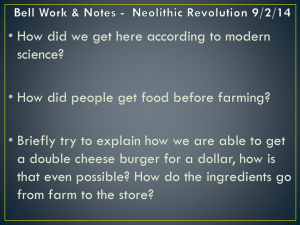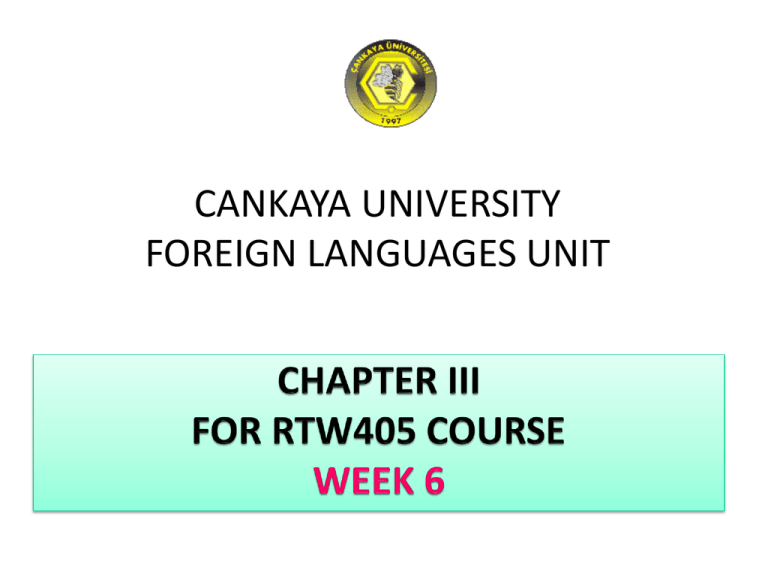
CANKAYA UNIVERSITY
FOREIGN LANGUAGES UNIT
CHAPTER III
PROCESS OF TECHNICAL WRITING
OUTLINE
1. Phase 2. Gathering Information
2. Phase 3. Planning & Arranging
3. Phase 4. Writing & Revising
PROCESS OF TECHNICAL WRITING
Phase 2. Gathering Information
• Research, the act of gathering information, is the second step of technical
writing process.
• Most writing projects require some degree of research.
• What are types of research?
Primary
Secondary
PROCESS OF TECHNICAL WRITING
Phase 2. Gathering Information
• See the example on page 52.
PROCESS OF TECHNICAL WRITING
Phase 2. Gathering Information
2.1.1. Conducting Primary Research
• Primary research has various forms.
• Typical sources of factual information for reports include:
interviews
observation
experimentation
surveys, questionnaires, and inventories
PROCESS OF TECHNICAL WRITING
Phase 2. Gathering Information
2.1.1. Conducting Primary Research
Interviews:
• You may need to interview experts in the field for your report.
• Talking with individuals directly concerned with the problem produces
excellent firsthand information.
For example, if you are researching whether your company should install
wireless technology, you could interview an expert in wireless technology
about the pros and cons.
• Interviews are usually conducted in person. However, it is possible to conduct
an interview over the phone or even by mail.
PROCESS OF TECHNICAL WRITING
Phase 2. Gathering Information
2.1.1. Conducting Primary Research
Observation:
• If you need observational data, then you need to plan the observations
carefully.
• One of the most important questions to ask is what or whom you are
observing and how often those observations are necessary.
For example, if you want to learn more about an organization’s customer
phone service, you probably need to use observation techniques, along
with interviews and perhaps even surveys.
You will want to answer questions such as, How long does a typical caller
wait before a customer-service representative answers the call? and Is
the service consistent?
PROCESS OF TECHNICAL WRITING
Phase 2. Gathering Information
2.1.1. Conducting Primary Research
Observation:
• Observation produces rich data, but that information can be subjective.
• Thus, to make observations more objective, try to quantify them.
For example, record customer telephone wait-time for 60-minute periods
at different times throughout a week.
This will give you a better picture than just observing for an hour on a
Friday before a holiday.
PROCESS OF TECHNICAL WRITING
Phase 2. Gathering Information
2.1.1. Conducting Primary Research
Experimentation:
• Experimentation produces data suggesting causes and effects.
• For example, assume that the Hershey Company wants to test the hypothesis
that chocolate makes people feel happier.
An experiment testing the hypothesis would separate depressed
individuals into two groups: those who ate chocolate and those who did
not.
What effect did chocolate have?
Such experiments require sophisticated research designs and careful
attention to matching the two groups.
PROCESS OF TECHNICAL WRITING
Phase 2. Gathering Information
2.1.1. Conducting Primary Research
Surveys, Questionnaires, and Inventories:
• Surveys collect data from groups of people.
For example, if you were part of a committee investigating the success of
a new e-mail program, you might begin by using a questionnaire.
When companies develop new products, for example, they often survey
consumers to learn their needs.
PROCESS OF TECHNICAL WRITING
Phase 2. Gathering Information
2.1.1. Conducting Primary Research
Surveys, Questionnaires, and Inventories:
The advantages of surveys:
• They gather data economically and efficiently.
• Surveys can be mailed to participants, or they can be administered online.
• Both mailed and online surveys reach big groups nearby or at great distances.
• Moreover, people responding to mailed and online surveys have time to
consider their answers, thus improving the accuracy of the data.
PROCESS OF TECHNICAL WRITING
Phase 2. Gathering Information
2.1.2. Conducting Secondary Research
• Secondary data are easier and cheaper to develop than primary data.
• Moreover, secondary data is where nearly every research project should begin
because, very often, something has already been written about your topic.
• Reviewing secondary sources can save time and effort and prevent you from
“reinventing the wheel.”
• Most secondary material is available either in print or electronically.
PROCESS OF TECHNICAL WRITING
Phase 2. Gathering Information
2.1.2. Conducting Secondary Research
i. Printed Materials:
• Print sources are still the most visible part of most libraries.
• Much information is available only in print.
• Print sources:
Books
Periodicals (magazines and journals)
Bibliographic indexes
PROCESS OF TECHNICAL WRITING
Phase 2. Gathering Information
2.1.2. Conducting Secondary Research
ii. Electronic Resources:
• From a computer you can access storehouses of information provided by the
government, newspapers, magazines, nonprofit organizations, and businesses.
• Business researchers are also using such electronic tools as mailing lists,
discussion boards, and blogs to conduct research.
• Electronic resources:
Electronic (online) databases
The web
Company records
PROCESS OF TECHNICAL WRITING
Phase 2. Gathering Information
2.1.2. Conducting Secondary Research
ii. Electronic Resources:
a. Electronic (online) Databases:
• A database is a collection of information stored electronically so that it is
accessible by computer and digitally searchable.
• Databases contain various forms of resources such as magazines, journals,
newsletters, business reports, government data etc.
• Databases provide both bibliographic (titles of documents and brief abstracts)
as well as full-text documents.
• Libraries offer free access to several commercial databases.
PROCESS OF TECHNICAL WRITING
Phase 2. Gathering Information
2.1.2. Conducting Secondary Research
ii. Electronic Resources:
The Web :
• The Web is unquestionably one of the greatest sources of information.
• Even though, the Web is easy to use and cheap, it has some disadvantages:
Finding trustworthy information can be time consuming.
The constantly changing contents of the Web and its lack of organization
irritate the researchers.
Content isn’t always reliable.
PROCESS OF TECHNICAL WRITING
Phase 2. Gathering Information
2.1.2. Conducting Secondary Research
ii. Electronic Resources:
Company Records:
• Many business reports begin with an analysis of company records and files.
• From these records you can observe past performance and methods used to
solve previous problems.
• See page 58 for gathering information task.
PROCESS OF TECHNICAL WRITING
Phase 3. Planning & Arranging
• After collecting your facts, you need a plan for presenting them.
• Common organizational patterns:
Order of location
Sequential order
Alphabetical order
Chronological order
Problem-solution
List
PROCESS OF TECHNICAL WRITING
Phase 3 . Planning & Arranging
PROCESS OF TECHNICAL WRITING
Phase 3 . Planning & Arranging
• What format should you use for the recommendation report you will prepare
for this course?
You should prefer problem-solution pattern which requires the
identification of the problem (or the situation) first, followed by the
solutions (or recommendations).
PROCESS OF TECHNICAL WRITING
Phase 4. Writing & Revising
• You can start writing your report by writing your purpose statement.
• Through the purpose statement, your readers learn about the situation
before reading the document in detail.
• After you state the problem and the purpose, you need to explain them in
the body part of the report by dividing your ideas.
• Dividing your ideas means writing the headings for each part.
• After writing the headings, you should start writing the paragraphs.
PROCESS OF TECHNICAL WRITING
Phase 4. Writing & Revising
• To write paragraphs, you can follow five basic guidelines:
Guideline 1. Develop topic sentences for paragraphs
Topic sentence is the sentence at the beginning of each paragraph
It summarizes the whole paragraph.
PROCESS OF TECHNICAL WRITING
Phase 4. Writing & Revising
Guideline 2. Develop support for topic sentences
An individual paragraph should not cover more than one topic. The
supporting sentences you create should be linked to the topic sentence.
Working from the outline and topic sentences you create, you can
develop supporting sentences in several ways:
1. By answering the implied question “Why is this true?” and supplying your
answers as a support
2. By recognizing the whole-to-parts relationship between bits of
information and making those connections clear to reader
3. By moving from general statement in the topics sentence to successively
more specific points in the body of the paragraph
4. By recognizing a chronological or sequential pattern ( working forward or
backward from the topic sentence)
PROCESS OF TECHNICAL WRITING
Phase 4. Writing & Revising
Guideline 3. Select appropriate language
A common problem is wordiness.
To avoid this, you may identify these by circling them:
Repetition: the use of same words or phrases several times in a single
passage
Prepositional phrases: used to indicate relationships between a subject and
an object, such as “after, at, before, by, from, in, of, to, with”.
Relative clauses: complete ideas that modify another part of the sentence,
beginning with “that, which, who, whom”
Expletives: words acting as fillers that add no meaning to the sentence, such
as “there is, there are”.
PROCESS OF TECHNICAL WRITING
Phase 4. Writing & Revising
Guideline 4. Select appropriate words
To improve word choice in your draft, you may identify the following
elements by circling them:
Noun phrases: groups of words that function collectively as nouns
(all those participating = participants)
Modifiers: words, phrases, or clauses that describe another part of the
sentence
(the temperature dropped extremely fast)
Passive constructions
PROCESS OF TECHNICAL WRITING
Phase 4. Writing & Revising
Guideline 4. Select appropriate words
To improve word choice in your draft, you may identify the following
elements by circling them:
Jargon: technical terminology, generally understood only by those schooled
in a specific discipline
(end-user computer, debug)
Highly connotative words and phrases: emotionally charged, judgmental, or
manipulative language rather than objective language
(despicable methods = suspect methods)
Generalities: vague, non-descriptive language that can cause confusion
(thing, seemed, something)
• See page 60 for rewriting activity.
PROCESS OF TECHNICAL WRITING
Phase 4. Writing & Revising
Guideline 5. Check the mechanics
You must be certain that your draft is correct in spelling, punctuation,
grammar, and format.
You can check the most common grammar mistakes:
Subjects and verbs do not agree
Nouns and pronouns do not agree in number and gender
Verb tense shifts. ( if you are using past tense, you must maintain it
throughout the document)
Voice shifts without reason form passive to active and back again.
Modifiers ( adjectives, adverbs, and relative clauses) are nor places as close
as possible to the part of sentence they describe.
Sentence fragments occur.
A comma is used when a conjunction, semicolon, or period is appropriate.
PROCESS OF TECHNICAL WRITING
Phase 4. Writing & Revising
The Review Cycle
• After writing the draft, you circulate it among your colleagues, technical
experts, or supervisors to ensure its accuracy and completeness.
• If your reviewers tell you about a problem and suggest changes, it is your
responsibility to evaluate and implement them as soon as possible.
• If necessary, you send your document to a second technical review to ensure
that the changes you have made are satisfactory.
• Then, you can submit it for approval to the proper authority.
PROCESS OF TECHNICAL WRITING
Outline
Rating Scale for Outline- Page 7
Sample Student Portfolio - Outline- Page 114
Topic:
• Choosing the Best Franchising Opportunity: Comparisons Between Starbucks
and Kahve Dünyası
Are there any problems with the sample ?
• Conclusion
NEXT WEEK
PORTFOLIO TASK 2: OUTLINE (in-class writing)
•
•
•
•
Decide your primary research method.
Search for secondary sources.
Bring your situational analysis and your sources to the class.
Bring a copy of the assignment sheet on page 12.

